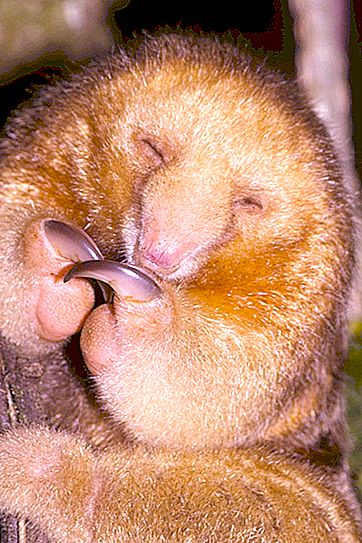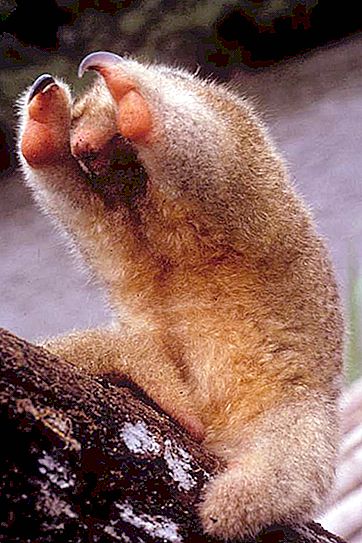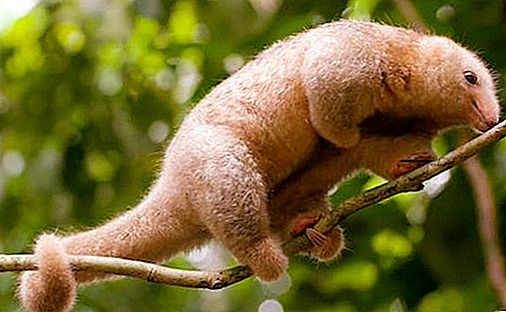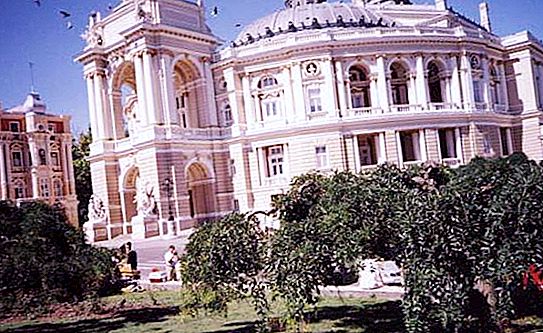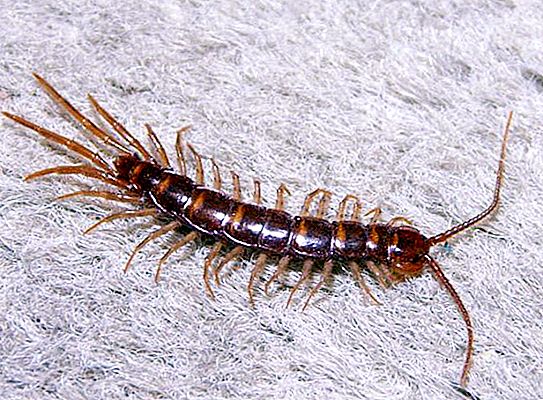The dwarf anteater is a representative of the order of the toothed, family Cyclopedidae, in some sources it is assigned to the subfamily Cyclopedinae of the family Myrmecophagidae. This small creature is the exact opposite of a giant congener, although it looks very similar to it (the same elongated muzzle, powerful claws). However, the smaller fellow has a tenacious tail, allowing him to move along the crowns of trees.
Description
The dwarf anteater does not grow more than 45 centimeters in length, while the tail reaches 18 centimeters. The animal weighs an average of 266 grams, the largest individuals reach 400 grams.
The creature's coat is short, brown, reddish-brown, yellow-golden. At the end of the face of the animal proboscis for eating ants and other insects. He has no teeth, but he has a large and muscular, sticky tongue. The soles of the paws and the tip of the nose of the animal are red.
The tail of the anteater is bare at the end. On the front paws, 4 fingers, two of which end in large claws, the other two are in their infancy. Five fingers on hind legs. It is because of two well-developed front fingers that the animal is also called “two-fingered”.
The body temperature of the animal is from 27.8 to 31.3 degrees. An interesting fact: this species of anteater has 64 chromosomes, while other representatives of this genus have only 54.
Habitat
The dwarf anteater lives in tropical forests, found in shrub savannahs. Distribution area - South and Central America: Brazil, Northern Argentina, territories from Mexico to Bolivia. It is assumed that the animal lives even in Paraguay, where it even has its own popular name - “Miko Dorado”.
It lives where it is possible to move through trees without descending to the ground.
How does he live?
The way of life of a dwarf anteater is nocturnal, that is, it is awake in the dark. In the afternoon, as a rule, he sleeps, curling up in a ball.
It lives on trees. It is believed that the animal most prefers trees from the genus Ceiba, since the crown of this plant is most similar in color to the color of the coat. And this is an additional opportunity to hide from danger. When it occurs, like other representatives of the family, it becomes in a protective stance, that is, it rises to the hind legs, and holds the front ones in front of itself. The animal is able to strike with its sharp claw.
This very slow creature can consume up to 8 thousand ants per day.
Family and Children
The dwarf anteater leads a solitary way of life, does not group in flocks. The mating season is in the summer.
Females bear cubs on average 135 days. During this time, she builds a nest in the hollow of the tree, laying it with dry leaves. As a rule, one baby is born, in the upbringing of which both parents participate. They feed him, belching semi-digested ants.
A few days after birth, the baby already begins to travel with parents who carry it on their body.
Recent research
For the first time a dwarf anteater (photos of the animal are presented in the article) was described by Karl Linney in 1758. Since then it was believed that this is the only representative of a kind.
However, last year, data from Mexican researchers appeared. Scientists during 17 expeditions to Suriname and Brazil examined 287 individuals, conducted molecular and other studies, and concluded that the animals are represented by seven groups. They differ genetically and, accordingly, can be assigned to different populations. Differences were found in the shape of the skull, texture and color of the coat. And molecular clocks proved that dwarf and other anteaters dispersed in their development 30 million years ago. The division within the genus of dwarf anteaters has formed over the past 10.3 million years. The evolution of individuals occurred against the background of changes in the nature of the Amazonian basin. Against their background, populations were isolated for a long time from each other, which gave impetus to the accumulation of significant differences in species.
